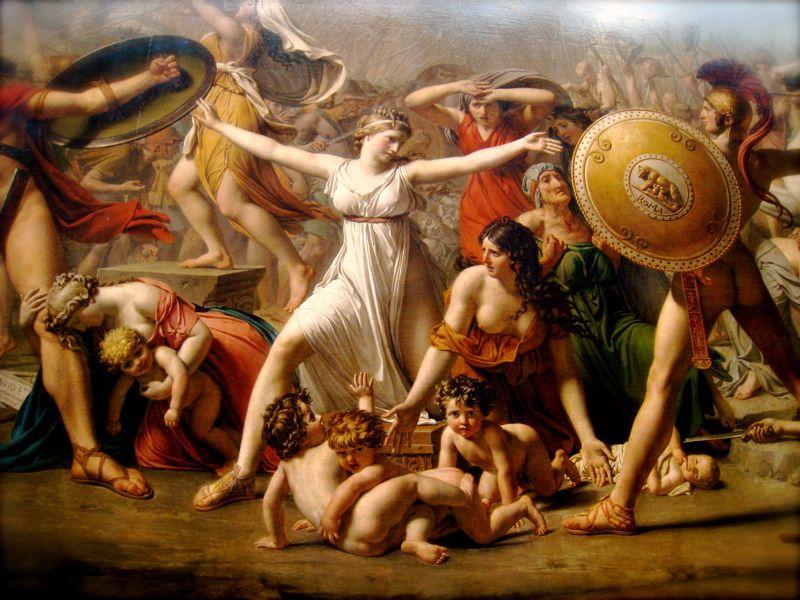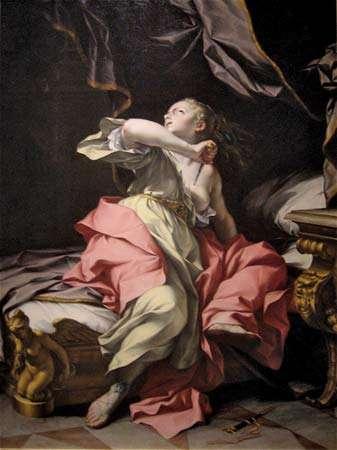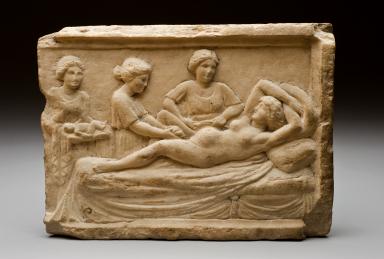
12 minute read
Pretty in Pink: The Expectations of Women in Rome Haley Bodner
Pretty in Pink: The Expectations ofWomen in Rome
Haley Bodner
Ancient Rome was a hotbed of masculine ideals, an empire built on the military triumphs
and the powerfulambitions ofmen. However, oftenforgotten to history are the women who
stood beside their fathers, husbands, and sons throughout their military and political careers.
Women, often confined to the household and rearing of children in many other ancient societies,
had a prevalent rolein Ancient Rome. Their responsibilitieschanged from the time of kings to
the time of emperors, but whatwas expected of their personalitiesremained constant. The purity
and grace of a daughter, the loyalty of a wife, and the kindness and knowledge of a mother were
all essential qualities for women throughout Rome’s historyas is shown through the works of
Livy and Ancient Roman funeral descriptions.
The instrumental role played by women in the founding of Rome isquite clearlyevident
even from its first origins; their significance is seen through the actions of the Sabine women.
When Romulus foundedRome, he invited the exiles of the surrounding towns. These men
wished for a new start, which Romulus offered
them in his new city on the hill. However, a
glaring problem struck the new Romans. Alack
of women would result in their city dying out in
the generation. Romulus’ legacy was to find a
great city, not one that would succumb to
fading out in his lifetime. To remedy this problem, Romulus called on the neighboring cities to
join Rome in the festival of Consualia, a festival honoring a deity of the harvest and stored
grains. Recently snubbed by the Sabines, Romulus’ plan primarily targeted them. As Livy tells it,
“The show began, and nobody had eyes or thoughts for anything else. This was the Roman’s
opportunity: at a given signal all the able-bodied men burst through the crowd and seized the
young women” (Livy 41). This is the story of the first women of Rome and how their actions
would make a lasting impression on the expectations of women for centuries to come.
To ease the worries of the taken women, Romulus moved among them and assured them
that married women would share in the fortunes of Rome. The men themselves echoed Romulus’
sentiments, speaking sweet words and promising that love had prompted their offense. These
words touched the women’s hearts and prompted them to forget their anger andforge proper
bonds with their new husbands. The frustrations of their fathers and brothers werenot so easily
talked away, however. The Sabines, along with several of the neighboring tribes, attempted to
wage war against the Romans, ending in a series of military defeats for the challengers.
Meanwhile, Rome grew stronger and improved their own reputation with their military victories.
The final advance of the Sabines was led by Mettius Curtius, who suffered humiliationfromthe
Roman’s charge. However, thebattle was never completed.
Seeing the slaughter of their fathers, brothers, husbands, and sons, the Sabine women
stepped intobattle. In Livy’s words, “With loosened hair and rent garments they braved the
flying spears and thrust their way in a body
between the embattled armies” (Livy 45). While
separating their warring families, the women

begged their fathers, protesting that “our children
are your sons-your grandsons: do not put on them
the stain of parricide…turn your anger against us. We are the cause of strife…we would rather
die ourselves than live on either widowed or orphaned” (Livy 45,46). Moments after this call for
peace, the rival captains stepped forward to officially outline the terms of peace. These brave
women united the two cities, doubling Rome’s population with their plea.
As one can see in the story of the Sabines, women were influential in Rome from the time
of the city’s foundation. The women had sway over their husbands and fathers, showing that
their opinions must have been valued by the men at that time. Thebravery and loyalty exhibited
by the Sabine women remained crucial traits to women in Rome. They were expected to defend
their husbands’ and fathers’ honor while still remainingloyal to their husbands.
These virtues of bravery and loyalty are once again praised in the first century BC, as
seenin funeral inscriptions made by husbandsto their wives. Most notably, inthe “Praise of
Turia” a mourning husband recounts his wife’s bravery throughout the turbulent civil wars.
While her husband was absent, Turia persecuted those who wished to steal her inheritance. After
her parents were murdered, she defended her and her husband’s claim to the inheritance “with so
much dedication, even if we [her husband and brother-in-law] had been present, we could not
have presented a better case than you did” (Inscriptions 453). As a result of her strong
arguments, the case was dropped against her. As told by her husband, “you had succeeded in the
task you had taken entirely upon yourself, namely to defend obligation to your father, your
familial duty to your sister, and your loyalty to me” (Inscriptions 453). This source was written
several hundred years after the Sabine women ended the war of their fathers and husbands, thus
exhibitingthat Romanmen continued to value the women in their lives.
In the “Praise of Turia,”her husband outlines the significance of her bravery and courage.
He dedicates several paragraphs of her funeral speech to outlining the amazing deeds she did.
Additionally, he highlights other praised virtues that she had in common with other women. Her
modesty, religious dedication, wool working, and general kindnessare all admired by her
husband (Inscriptions 453). These virtues were also praised in other funeral speeches to mothers,
wives, and daughters, showing how widely these qualities were desired in the society.
Although many of these funeral inscriptions are shorter than“Praise of Turia”, they
convey the same raw emotions of grief and love. Children wrote of their mothersso that they
could “recall her many great deeds, as a way of healing the terrible wound of grief that gnaws at
our hearts” (Inscriptions 470). In these speeches and engravings, people praise the other
significant virtues that Turia’s speech breezed over. A father highlights his daughter’s superior
beauty along with her skills in wool-spinning and singing. Grieving children remembertheir
mother’s truthful nature, reverence for the gods, good sense, fertility, and chastity(Inscriptions
469).
While many of these virtues expected of women originate from the Sabines, the
expectations of chastity can be traced back to the founding of
the republic. Under the reign of King Tarquin the Proud, the
princesdecided that they would have a contest of wives. One
soldier claimed that Lucretia will win without a doubt. When

they met her, she is spinningwoolwhile the otherwives were
engaged in a gluttonous feast (Livy 100). Sextus Tarquinius
fell in love with her at first sight and made plans to take her.
When night fell, Sextus snuck into Lucretia’s room and threatened her with death. She did not
fear death butsuccumbed to his threat of dishonoring her and allowed Sextus to have his way
with her. In the words of Livy, “even the most resolute chastity could not have stood against this
dreadful threat” (Livy 101). Lucretia wrote to her fatherand husband, urging themto come toher
immediatelywith a trusted friend. Upon arrival, she explained what had happened. All three men
claimed she was innocent of the sin as “it was the mind…that sinned, not the body: without
intention there could never be guilt” (Livy 102). Despite this, Lucretia committed suicide after
they promised thatSextus would be punished. The trusted friend, Lucius Brutus, swore on her
blood that he would avenge her. Returning to Rome, Brutus and the others present drove the
Tarquin family out of the city by turning the population against the tyrant.
Lucretia’s chastity was valued among women throughout Rome’s history. Adulterous
actions were punishable by death or banishment for women. At the fall of the Republic, the
loyalty and chastity of a man’s wife had significant ties to the man’s reputation as well. Gaius
Julius Caesar divorced his second wife, Pompeia, on the suspicion of adultery with a Roman
politician (Suetonius 3). The suspected action led to a judiciary inquiry into the politician and
Pompeia, thus beginning the Bona Dea scandal. However, this same code of conduct was not
held to men as Julius Caesar became knownas “every woman’s husband and every man’s wife”
(Suetonius 25). This emphasis on women’s loyalty was ingrained into many ancient societies,
and Rome was no exception to this rule.
However, compared to many civilizations present in the Mediterranean basin and Middle
East during this time, Roman women enjoyed many freedoms. The women of classical Athens
were expected “to live secluded lives, out of the public eye, largely segregatedfrom men and
male social life” (Beard 307). In contrast, Roman women seemed to enjoy much more freedom
in a more integrated society. The household was not divided into male and female spheres, and
many women in Rome did assist their husbands in business. In an epigraph in dedication to his
wife, a Romanman spoke of his wife as an “ally in [his]business dealings in Rome” crediting her
with keeping the house safe. The epigraph also mentions that the wife helped her husbandin
advising him in business, showing that a women’s intelligence in business, and the home was
valued among the populace(Inscriptions 471).
This involvement in business andmore flexible household gender rolesallowed for women in
Rome to have much more freedomthan their counterparts in other ancient civilizations.
Most shocking compared to other ancient civilizationsis the right to property that women
held. When married, a womandid not have to become the property of her husbandor take his
name, insteadshehad the choice to remain the property of her father, thus securingher
inheritance. After her father’s death, a woman was entitled to aninheritance, buyingand selling
property in her own name, creatinga will, and freeingher slaves, provided that she was still a
member of his family(Beard 308). These rights werenearlyunheard of in the ancient times, as
the woman often lost her inheritance to her husbandwhen she married. By giving women the
choice to remain the property of their father’s family, Rome once again shows to be more
progressive then other ancient civilizations. Not unlike other civilizations, Rome required
women to have a guardian, known as a tutor, approve her decisions and transactions. When
Augustus came into power during the early Empire, one of his reforms was to remove the
required guardian for freeborn women who had three children; for women who were ex-slaves,
four children were required. When Roman women fulfilled their womanly virtues, in this case
having threeor more children, they were granted additional freedoms. However, in other
societies, these virtues were merely expected of the women. In these other societies, a woman’s
virtues were not acknowledged in a political or social sphere.
As was custom in every ancient society, women in Rome were expected to marry and
have children. When belonging to the higher classes, women had little control overwhomthey
married. Their marriages were often to secure their father’s or brother’s political campaigns by
using a marriage to gather allies. During the First Triumvirate, Gaius Julius Caesar married his
daughter Julia to his allyPompey to secure his loyalty. These political marriages were not always
unhappy. Pompey and Julia were believed to have been deeply devoted to each other, to the point
where her death led to the breakdown of Pompey’sand Caesar’s political alliance (Beard 310).
Through her marriage, thewoman wasexpected to give birth to an heir for her husband.
A wife’s fertility wasone of the many praised attributes in the epigraphs recovered from the
Roman Empire. However, this expectation carried a
large risk to a woman’s health during this time.
Childbirth was the biggest killer of young women

throughout the ancient world, to which Rome was
no exception. The lack of hospitals and modern
medicine led to many deathscaused by hemorrhages, infections, and obstructionsthat are now
preventable. Also lacking any form of reliable contraceptives, women spent a large portion of
their lives pregnant. If theysurvived childbirth, women were still not guaranteed an easy life. As
manyas half ofthe children born in Rome died before reaching ten years old, creating a cycle of
mourning for the family. Despite past speculation that the high infant mortality rate meant
ancient parents did not create emotional attachment to their children, they in fact did mourn the
loss of each of their children (Beard 317). Many touching epigraphs expressedthe grief of
fathers and mothers, oneto an infant who left behind her “grieving mother and father” tells that
they both“weep for her as she lies, little body enclosed in a marble tomb” (Inscriptions 472).
The expectation to bear children with terrible odds for their own survival while also having to
overcome the depression thatmust follow losing a child, show that the women of the time were
expected to be both mentally and physicallystrong.
The expectations for Roman women spana wide spectrumof traits: bravery,
courageousness, modesty, loyalty, chastity, intelligence, beauty, fertility, and strength. Despite
the factmany ancient societies expected women to take a subservient role in society, the
personality expected of Roman women clearly painted by Livy and the funeral epigraphs shows
them in a brighter light. The women ofAncient Rome were valued for more than just their
beauty and fertility, with many having to be the main breadwinner when their husbands were in
political exile. The more diverseduties expected of a woman in ancient Rome also lead to a
lengthier list of personality traits for an ideal woman, but with this came more freedoms than
anywhere else in the ancient world.
Works Cited
Beard, Mary. SPQR: A History of Ancient Rome. New York: Liveright, 2015.
David, Jacques-Louis. “The Interventionof the Sabine Women.”1799. Daily Art Magazine. Musee du Louvre. http://www.dailyartmagazine.com/the-time-intervention-sabinewomen/.
“Inscriptions.” In Ancient Rome: An Anthology of Sources. Edited by Christopher Francese and R. Scott Smith. Indianapolis: Hackett, 2014.
Livy. The Early History of Rome. Translated by Aubrey De Sélincourt. London: Penguin Classics, 2002 “Marble plaque showing parturition scene.” c.400BCE-300CE. Brought to Life. Science Museum London. http://broughttolife.sciencemuseum.org.uk/broughttolife/objects/display?id=92258.
Mazzanti, Ludovico. “The Death of Lucretia.” c.1730. Britannica. Los Angeles County Museum of Art. https://www.britannica.com/topic/Lucretia-ancient-Roman-heroine.
Poussin, Nicolas. “The Rape of the Sabine Women.” Sartle. Louvre Museum. https://www.sartle.com/artwork/the-rape-of-the-sabine-women-nicolas-poussin.
Suetonius. The Twelve Caesars. Translated by Robert Graves. London: Penguin Classics, 2007.


